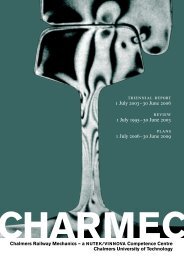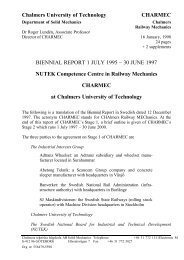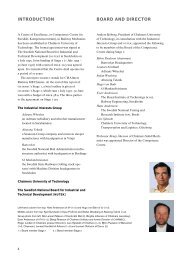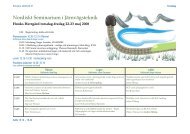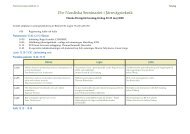Create successful ePaper yourself
Turn your PDF publications into a flip-book with our unique Google optimized e-Paper software.
Interaction of train and track – Samverkan tåg/spår (TS) – Wechselwirkung von Zug und Gleis – Interaction entre le train et la voieTS5. OUT-OF-ROUND WHEELS – CAUSES AND CONSEQUENCESOrunda hjul – orsaker och konsekvenserUnrunde Räder – Ursachen und KonsequenzenDéfaults de rondeur des roues – causes et conséquencesProject leaderand supervisorAssistant supervisorDocent Jens Nielsen,Applied MechanicsProfessor Roger Lundén,Applied MechanicsDoctoral candidate Mr Anders Johansson,(from 2000-08-01;Lic Eng September <strong>2003</strong>)Period 1998-05-01 – <strong>2003</strong>-06-30(– 2005-06-30)Chalmers budget Stage 2: ksek 1300+150(excluding university Stage 3: ksek 2150+850+200+100basic resources) Stage 4: ksek 1300+600Industrial interests Stage 2: ksek 300+200+100in-kind budget (Banverket+SJ+Duroc)Stage 3: ksek 300+100+50(Banverket+Duroc+TrainTech)Stage 4: ksek 100+100+50(Banverket+Duroc Rail+TrainTech)Railway traffic with out-of-round wheels leads to increaseddynamic stresses in both track and vehicle withfatigue fracture as the most serious consequence. In thets5 project, the causes and consequences of long-waveout-of-roundness (oor) of the wheel tread (from onlyone wave up to a total of five waves around the circumferenceof the wheel) constitute the primary subject ofinvestigation. Both field studies and numerical simulationsare being performed. A database of the most frequentwheel damage in Sweden is to be established withregard to wheel type, train speed, axle load and typeof traffic. One of the objectives in the project is to determinewhich amplitudes and wavelengths in the oor areimportant in the interaction between train and track, andto study how these should relate to appropriate criteriain wheel damage detectors. It should be possible to setlimits for permissible oor and propose measures forcounteracting oor. The project was started during 1998-1999 with a comprehensive study of the literature, seereference in the charmec <strong>Triennial</strong> <strong>Report</strong> from Stage 2.The full-scale tests with a freight train provided with anumber of deliberate types of wheel damage (wheel flats,local spalls, periodic oor, long local defects) took placein the spring of 2000 at Grundbro on the Svealand Line.These have now been evaluated and used for calibrationof a mathematical model. The tests were carried out inco-operation with Banverket, sj and Adtranz Wheelset(now Lucchini Sweden). Two different axle loads werestudied in combination with speeds in the range 30 to100 km/h.Wheel polygonalization in the Stockholm subway hasalso been investigated assuming straight track. Throughnumerical simulations, important “wavelength-fixingmechanisms” of wheel oor have been determined.These are the p2-resonance (wheelset, rail and sleepersvibrating in phase on the ballast/subgrade) and a verticalantiresonance of the track. Unfortunately, the predicted18



